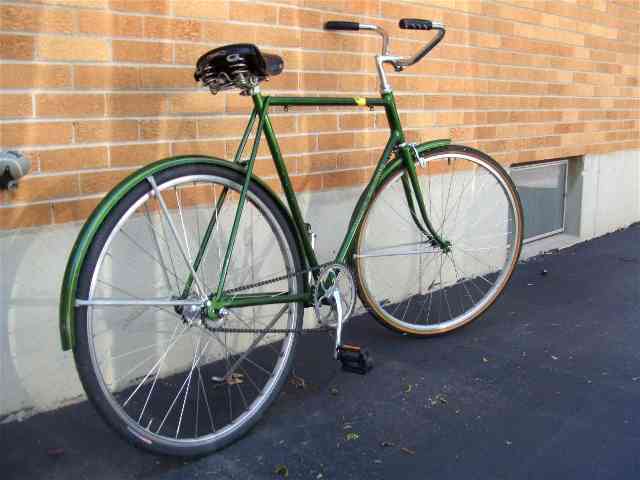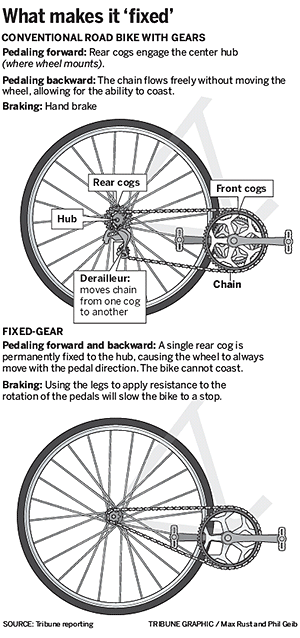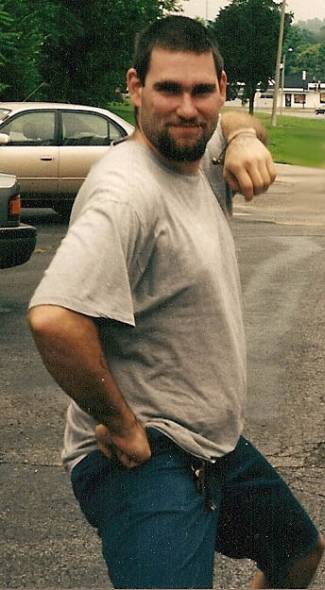 Well, I have to admit, when I saw the bike I knew nothing about it. I just thought, hmmm "It's ugly and weird and it just looks like a bike from a garage sale or something" I was totally wrong. I guess I was looking at one of Brad's treasures and did not even know it. After Marianne explained the fixed gear thing to me she dared me to get on it "Go ahead, try it, c'
Well, I have to admit, when I saw the bike I knew nothing about it. I just thought, hmmm "It's ugly and weird and it just looks like a bike from a garage sale or something" I was totally wrong. I guess I was looking at one of Brad's treasures and did not even know it. After Marianne explained the fixed gear thing to me she dared me to get on it "Go ahead, try it, c' mon, you gotta try it" Thank goodness I felt lazy that day! I did not try it. Well now I have read about it and what is really twisted is now I can't wait to try it. I now understand why Brad had this bike. This type of thing is Brad. Here are the pictures of his Fixie that Marianne took (Thanks!) and the articles from the Chicago Tribune that explain it all. Well, this bike we will definitely be keeping.
mon, you gotta try it" Thank goodness I felt lazy that day! I did not try it. Well now I have read about it and what is really twisted is now I can't wait to try it. I now understand why Brad had this bike. This type of thing is Brad. Here are the pictures of his Fixie that Marianne took (Thanks!) and the articles from the Chicago Tribune that explain it all. Well, this bike we will definitely be keeping.
No brakes, and they like it
Brakeless bikes are the latest in-thing for the cycling set. But amateur riders pose a hazard to others, observers say.
| Chicago Tribune reporter August 31, 2008
Different frames and colors flashed in the streetlight—a Cinelli Vigorelli, sleek and white; a red Motobecane with purple grips.
But in a controversial and increasingly popular trend, not one of the bicycles had brakes. As the cyclists glided onto the streets on their fixed-gear bikes, the only way for them to slow down was to force the rear wheels into a skid.
State law prohibits riding brakeless bikes on the streets, but that hasn't stopped a growing number of young people from hitting the road with bicycles they see as pure and stripped-down.
Fixed-gear bikes
 .
.
"There's no way that someone could go out on the streets and ride safely without brakes," said Aram Bayzaee of Northbrook, who races a brakeless fixed-gear bike on an outdoor velodrome track.
Critics are particularly contemptuous of wannabe bike messengers they say are wiping out, flying through red lights and crashing into people.
"They're a public safety hazard," said Andrew Floyd, 31, of Chicago, a longtime cyclist who has ridden a fixed-gear bike without brakes on the street for years.
The Chicagoland Bicycle Federation says fixed-gear riders comprise an extremely small percentage of the cycling demographic. But Eric Pitts, owner of Smart Bike Parts in Avondale, said he thinks people would be surprised by their growing numbers.
"I'd say 1 out of 20 bikes in
Constant motion
With a fixed-gear bike, the gear connecting the rear wheel and pedals is threaded onto the hub and secured with a lock ring. Whenever the rear wheel is turning, the pedals move in the same direction, and vice versa.
Stopping one of these bikes requires both skill and strength. When riding on the street, cyclists lift the back wheel off the ground by locking their legs, then bring it back down, forcing it to hop or skid.
Riders say their fixed-gear bicycles are easy to maintain and make for a Zenlike riding experience because all the control comes from the legs and mental focus is crucial.
With the legs continuously in motion, it's easier to shed weight and beef up the calves, cyclists say. But perhaps most important are the aesthetics—the streamlined bikes look sleek and cool.
Josh Magnus, 27, a longtime cyclist, swore he would never ride a fixed-gear bike without brakes. The paralegal from
Then, 2 1/2 years ago, he climbed on one at the urging of a friend.
"At first I said, 'Are you out of your mind?' " Magnus recalled. "But after five minutes of riding, I was hooked. I'll never ride another bike again."
Some fixed-gear bikes, called track bikes, are designed for use on velodromes—banked racing tracks—and do not have a hand brake. Other types come with brakes, which can be removed and often are. Prices range from $300 to thousands of dollars.
Bike messengers started riding fixed-gear bikes without brakes in the 1990s, first in
But many buy new models, and manufacturers are scrambling to meet demand. California-based Specialized launched two fixed-gear Langster models in 2003 and now offers six, including the Langster Chicago decorated with an image of the city skyline. Five of the models come equipped with brakes, which the company recognizes don't always stay on.
"There are a lot of new people getting into it," said Don Langley, a Specialized product manager and longtime velodrome racer for whom the Langster is named. "Some people take the brakes off to make it a more pure form of cycling."
Skateboarders and fans of BMX bikes are among those who have been drawn to the brakeless trend, said Alex Gonzalez, 20, who grew up in
"Before I left, a lot of people were skating, but now everyone is riding fixed-gear," said Gonzalez, who is hooked on his Cinelli Supercorsa Pista. "It's like the new subculture. It's as dangerous as skating. You can cut through cars, go through red lights, do tricks."
Fuzzy math
Bike federation officials stress there are more serious threats to public safety than brakeless bikes, such as riding at night without lights. They argue the hazard is reckless riding—not the type of bike.
Crash—when not if
But cyclists complain that novices on brakeless bikes are especially dangerous. Even experienced riders of the bikes say they are destined to crash.
"It's not a matter of if you wipe out, it's when," Magnus said.
Ben Van Couvering, 26, of
Most experienced cyclists try to reduce the already-sizable dangers by installing at least one brake on such bikes, he said.
"In the end," he said, "brakeless fixed-gear bikes belong on the velodrome and nowhere else."
'How difficult could it be?'
| Chicago Tribune reporter August 31, 2008
I may not be the most sophisticated cyclist, but I've been biking since age 6, when I awoke on Christmas morning to discover a shiny, red Schwinn under the tree.
Today, I ride my Specialized Crossroads in my free time, taking 15- or 20-mile trips along the lake or exploring
So when I began reporting a story about the popularity of brakeless fixed-gear bikes, I was determined to try one.
How difficult could it be?
Josh Magnus, whom I had interviewed, agreed to let me borrow his new Cinelli Vigorelli.
After meeting outside
He looked at me with pity.
"If you were going to ride this bad boy down
He paused before adding, "Just don't fall."
I rolled up my jeans and sat on the bike.
There were clips to lock my feet to the pedals—apparently one of the best ways to exercise control. But I placed my feet on the reverse side, fearing I would not be able to pull out of the clips in time if I ran into trouble.
As soon as I pushed down on the left pedal, I realized this was radically different than riding a multiple-gear bike with brakes. At no moment were my legs still. As long as the wheels moved, the pedals moved.
Freaked out, I pressed back on the pedals in an effort to slow down and stop. But I didn't press hard enough, so the pedals pushed me up off my seat. I could understand how people get thrown from bikes like these.
Experienced riders had told me how they lift the back tire off the ground with their legs and bring it down in a hopping or skidding stop. But no way was I going to try that.
Within 30 seconds, I had dismounted and thrust the bike back in Magnus' hands.
He looked relieved.
Nothing bad had happened. I wanted to leave it that way.

Comments
marianne
You gotta' try it.
Wed, 09/03/2008 - 12:04amBut now that I've read how to stop it, by bouncing & skidding the back tire, I'm not so sure I want to ride it again.